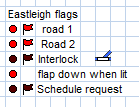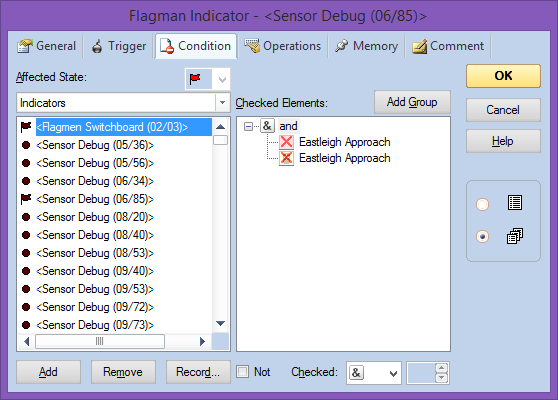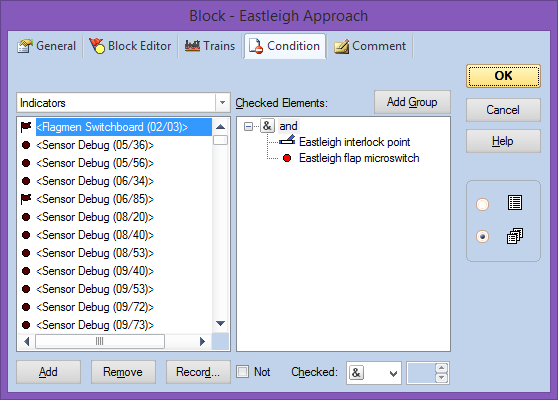If you have an area of track where you will be operating trains by hand - for example shunting in a yard - it is great to use a DTM30 to set the points using pushbuttons. On other parts of the railway - for example a main line - it's great to have Traincontroller drive trains automatically, so it controls the points. But what happens where they meet - for example, if Traincontroller drives a train into the yard?
DTM30 interlocks provide a way to arbitrate between locally controlled points and Traincontroller controlled points. When you request to use the area of track locally, Traincontroller will grant that request if it hasn't reserved that track for a train movement; thereafter, it won't try to use that track until you've given back control. At the DTM30 end, point cells assigned to an interlock won't operate from button presses until the interlock has been granted.
How it works
An interlock cell is a special DTM30 cell. It sends a sensor message to LocoNet when its pushbutton is pressed. It then waits for a point address to be set to THROWN if the interlock is granted by Traincontroller. If that doesn't happen, the request times out after about 10 seconds. If the request is granted, the interlock cell LED lights and points assigned to the interlock will then work.
How to Set up Traincontroller
Interlocks are not a feature of Traincontroller: this is a process we have worked out experimentally ourselves. Here's how we have programmed it to control access into Eastleigh depot: this is a goods depot accessed from a main line.
Firstly, you will need to set up a contact indicator for the interlock's sensor message. This will light up red when the sensor is active. Then you'll need a Flagman triggered by that contact indicator. The flagman will also light up red when the sensor is pressed. (In this case they are the "interlock" row shown here). Then add a turnout that isn't part of your railway, with its DCC address set to the address programmed into the DTM30 interlock cell. Finally you'll need to add a block on the road into the yard, if you don't already have one. Ours is too short to allow a train to stop there, so it is set as a critical section.

The interlock's flagman now needs a condition: this is something that would stop it from operating. In this case it is programmed to trigger if Eastleigh approach is NOT occupied, and Eastleigh approach is NOT reserved. This means that the flagman can only become active if Traincontroller is not trying to drive a train through there at the moment.

Next we added Operations to the flagman. These set the "phantom" turnout to THROWN if the flagman is active, and set it to CLOSED if the flagman is not active. (The action now will signal to the DTM30 that the interlock has been set).

Finally we added a condition to the block on the approach road, which only allows the block to be reserved if the phantom turnout is CLOSED. This stops Traincontroller driving a train in if the interlock is active. (There's also a condition in here to stop Traincontroller reserving the block if the depot track bed has been raised - it is on a lift-up panel for access to track below; a microswitch sends a sensor message via a DAC20 input if the panel is raised).

So that's the interlock process; press the DTM30 interlock button, and if the request can be granted the flagman will set to red and activate the phantom turnout. Traincontroller will now hold any incoming traffic at the block before, and wait.
Controlling which tracks can be used
Finally, it's sometimes useful to control which tracks can be used by Traincontroller - in a busy station, to force using certain trains for example. It's easy to do this from a DTM30 too.
In the DTM30, program a cell to be a sensor cell with an LED for the sensor and a pushbutton to change the sensor on/off each time it is pressed. When you press the button, the LED lights and LocoNet gets a "sensor occupied" message. Press it again and the LED goes off; LocoNet gets a "sensor not occupied" message. You will need one LED & pushbutton for each track you want to control; a DTM30 sensor cell can have two sensors, LEDs and pushbuttons.
In Traincontroller, add a contact indicator to a switchboard for each track and set the LocoNet address. Then when the DTM30 LED is lit, the contact indicator will light. Add a flagman for each, triggered by the respective contact indicator. Now the flagman will light when the DTM30 LED is lit. Finally program block operations for the flagman lit and the flagman not lit. When lit, allow entry and exit at the appropriate of the block on your switchboard. When not lit, lock exist and entry at that end of the block.

